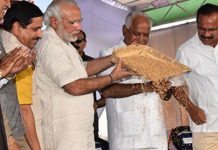
Master of makeovers
As most of the known leaders of the opposition parties, including Jan Sangh, were arrested, the RSS and its regional shakhas took on the mantle to oppose Indira. In Gujarat, the Sangh formed a new organisation, Gujarat Lok Sangharsh Samiti (GLSS), which held a secret meeting under a regional rss Pracharak, Inamdar (who had ordered Modi to join the RSS), and took the decision to carry on with subversive activities.
The first priority to achieve this objective was to ensure that the leaders, who were still in the open, were not arrested by the government. Thus, safe houses had to be found and money had to be arranged for their stay and travel. Many of these leaders shifted their safe houses several times, and lived in several states. The Gujarat RSS was among the prominent section to do this work.
Modi became an important cog in this secret wheel of providing safety and security to important individuals. He realised this when he was asked to meet Prabhudas Patwari, a known lawyer and rss activist, at night in July 1975. Patwari informed him that George Fernandes, a well-known socialist, was in town, and Modi had to take care of him. Modi, who knew Fernandes, met him fondly.
In their book on Modi, MV Kamath and Kalindi Randeri quoted Modi as saying, “Fernandes was unrecognisable. He was wearing an unironed Lucknavi kurta, a checkered lungi and a green cloth tied on his head. Besides, he had grown a long beard (in a bid to escape arrest) and looked like a Muslim fakir.” Modi did his job impeccably; Fernandes and rss leaders were impressed.
From then on, Modi took care of several individuals, which included rss Swayamsevaks, and ensured that they stayed out of trouble. He also arranged their travels in case they had to change safe houses or move to another state. Thus, the future prime minister became a master in organising illegal stays, hoodwinking police and other authorities, and establishing a loyal and trustworthy network.
More importantly, Modi became a master of disguises, as he tried to remain free, and was given more pressing responsibility to pass on crucial information to other leaders. Once he donned the garb of a Sanyasi, along with the saffron clothes. On another occasion, he grew a beard, and dressed up like a Sikh. In a few months, he became confident and took on challenging jobs that others refused.
In his book on Modi, author Andy Marino cites several ‘apocryphal’ stories “of current pm’s actions designed to show his character in a flattering light” during the Emergency years. Modi apparently broke into Bhavnagar jail to meet journalist Vishnu Pandya, and politician Shankarsinh Vaghela (now his sworn enemy in Gujarat), and pass on some information to them. To escape the police authorities, he went with a lady escort, who was a regular visitor to the prison.
Marino adds that “after (Nanaji) Deshmukh’s arrest, it was discovered that the papers he was carrying were still with him. These contained plans for the future actions of the glss, and it was essential somehow to retrieve them. To this end, Modi planned a distraction with the help of a female Swayamsevak…. They went to the police station where Deshmukh was being held. While she posed as a relative…, Modi somehow took the documents from under the noses of the police.”
Master of communications
Another important job that Modi was entrusted with was to disseminate information about the excesses of the Emergency to the masses, including the underground workers of the rss and glss, as well as leaders who were in hiding. He was asked to organise the printing and distribution of various pamphlets and booklets on relevant issues that could encourage the people to revolt.
Sometime in 1975, Indira organised an international conference, where she invited Parliamentarians from the Commonwealth nations. The RSS felt that this could be a great opportunity to spread anti-Emergency and anti-Indira views to a global audience. Modi was entrusted with the task of printing five booklets for the event. These were: Indian Press Gagged, Fact vs Indira’s Lies, 20 Lies of Indira Gandhi, When Disobedience to Law is a Duty, and A Decade of Economic Chaos.
Modi went scurrying to look for printers, who would have the courage to print the booklets, and in utmost secrecy. But then he was given a difficult job – to transport the hundreds of booklets to New Delhi so as to distribute them among the Commonwealth Parliamentarians. Finally, the delegates at the global conference did get the booklets, and Emergency became an international debate.
In October 1975, Indira’s critics, including the rss, decided on a nationwide Satyagraha on 14 November. The date was significant, the birth anniversary of Jawaharlal Nehru, Indira’s father. It was a masterstroke – to hold a non-violent protest against Indira on her father’s birthday. The event was kept secret; according to Kamath and Randeri, the code word for the Satyagraha was ‘Marriage Date Fixed’.












